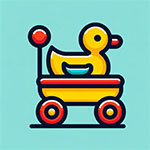
Fostering independence in toddlers is a crucial step in their development, with self-dressing being a key milestone. This guide will delve into strategies for encouraging self-dressing skills in toddlers, focusing on selecting clothes with simple fastenings, using dressing dolls or toys for practice, and providing additional strategies tailored to specific age ranges.
Select the Right Clothes
For 18-24 months
- Simple Fastenings: Introduce clothes with large buttons, Velcro, and elastic waistbands. These are easier for small hands to manage.
- Loose-Fitting Clothes: Opt for clothes that are easy to put on and take off, such as wide-neck shirts or loose pants, to minimize frustration.
For 2-3 years
- Practice Snaps and Zippers: Clothes with snaps and zippers can be introduced as your child’s dexterity improves. Start with large zippers on jackets, which are easier to handle.
- Encourage Sock Mastery: Socks can be tricky, so look for those with fun patterns or textures to make the practice more appealing.
Practice with Dressing Dolls or Toys
For 18-24 months
- Simple Dressing Dolls: Use dolls with large, easy-to-use clothes and fastenings. This introduces the concept of front and back, inside and outside.
For 2-3 years
- Advanced Dolls: Gradually introduce dolls with a variety of clothing types and fastenings, including zippers, buttons, and buckles to enhance fine motor skills.
Break It Down into Steps
For 18-24 months
- Start Simple: Begin with teaching them to remove easy items like hats and socks. Celebrate these early successes to build confidence.
For 2-3 years
- Add Complexity: Introduce putting on pants and shirts by breaking down the steps. Use verbal cues like “arms first” or “head through the hole.”
Create a Routine
For 18-24 months
- Consistent Dressing Times: Make dressing a part of the daily routine, like after waking up or before bedtime stories, to build habituation.
For 2-3 years
- Incorporate Choices: As part of the routine, let them choose between two outfits. This age group enjoys making decisions and it encourages engagement in dressing.
Encourage Choice
- Provide Options: Give toddlers a limited selection of clothes to choose from. This helps them feel in control and makes dressing an exciting activity.
Be Patient and Offer Support
- Positive Reinforcement: Celebrate each attempt, regardless of the outcome. Use encouraging words and show them how proud you are of their efforts.
Additional Strategies
Layering Game
Introduce a game where you and your toddler take turns adding layers of clothing. This fun activity can teach them about different clothing items and their order of wear.
Visual Cues
Use pictures or icons to show the order of clothing items to put on. This can help them remember the sequence and make dressing a more independent task.
Dressing Races
Turn dressing into a playful competition. See who can put on a t-shirt the fastest. Ensure it’s fun and not frustrating, with the focus on participation rather than winning.
Real-Life Examples
Show them how you dress yourself or have older siblings demonstrate. Toddlers often learn best by mimicking others.
Conclusion
Encouraging self-dressing in toddlers is a blend of offering the right tools, breaking down the process into manageable steps, and incorporating fun, educational activities. By tailoring strategies to their developmental stage, you support their journey towards independence. Remember, each child progresses at their own pace, so patience and encouragement are key.





